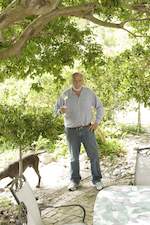Peter’s development of Bouchard Finlayson was devotedly Burgundian. Vines were planted in dense rows to naturally curtail yields for greater flavour concentration: initially 7 500 (later 9 000) Pinot vines per hectare and 3 500 (later 6 000 -9 000) Chardonnay vines per hectare, almost double that of the local industry norm.

He paid frequent visits to Burgundy, developing a working relationship with leading Burgundian vintner and barrel supplier Bruno Lorenzon. He was picky about clones, selecting new Burgundian types. Barrels came from specialist Burgundian cooper Meyrieux, particularly fussy about the degree of toasting, especially as required by the notoriously tricky Pinot.
Although perceived as a delicate wine, it has the most tannin of almost all red varieties, which requires fine judgement and close attention to detail in harvesting, vinification and maturation. The slightest lapse of focus can lead to spectacular failure; it's why it's known among winemakers as 'the heartbreak grape',
Despite widespread acclaim for his wines over the next decade, Peter only felt he'd 'arrived' as a Pinot producer when his flagship Tete de Cuvee Galpin Peak was awarded the trophy, not just for best Pinot Noir but best Burgundy, on show at the 2000 International Wine Challenge, competing with some top exponents from that region.
Since then, the accolades have continued to come. He now makes three Pinot Noirs and four Chardonnays. Besides the Tête de Cuvée Galpin Peak, there's the Galpin Peak and sometimes something special for the Guild auction. All are from the domain's 22 hectares of predominantly Pinot vines among the 125 hectares of rehabilitated fynbos, about which Peter is almost as passionate as his Pinot.
The collection of chardonnays includes the top-notch Kaaimansgat/Crocodile's Lair and a limited edition of the same wine from vaunted Villiersdorp snow-line vineyards; the Missionvale Chardonnay; and the unwooded Sans Barrique Chardonnay.
'Although following the Burgundian way in growing and making my wine, I've never tried to emulate the style. Our terroir is different and each terroir leaves its own fingerprint.'
Bouchard Finlayson's cool climate also called for Sauvignon Blanc, vinified with other Hemel-en-Aarde fruit, but now all own grapes. The all-purpose white blend Blanc de Mer is a varietal all-sorts from vineyards further afield. But it’s an unusual red combination that has showcased his deft hand at blending beyond Burgundy and Bouchard Finlayson's trademark classical elegance.
The Hannibal, introduced with the 2001 vintage, was the result of his exploration of Italian varieties sangiovese and nebbiolo. A first for the Cape, they contribute to this full-blooded, spicy red in combination with out-sourced Mediterranean varieties such as Shiraz, Mourvedre, Barbera and, very experimentally yet to surprisingly good effect, some of his beloved own Pinot Noir. This is Peter at play, producing a powerhouse that speaks of his versatility. It's also a wine perhaps more suited to his oft quoted allegory of winemaking, not always as art, but as a sport.
'Wine may be an art. But an artist can tear up a canvas and start again. As a winemaker you only get one chance a year to do the best you can with what the vintage gives you. So each vintage is like a cricket or rugby match: you come out and play your best game and each time one of your wines is opened, there're spectators commenting on and evaluating your performance, and deciding whether they'll pick you again.'
Wine lovers and connoisseurs continue to rate Peter Finlayson as an A-team player, although he no longer owns Bouchard Finlayson. In 2000 ownership changed. Controversial South African-born international travel and hotel mogul Stanley Tollman acquired a majority shareholding. Peter remained a shareholder and MD until eventually selling his stake.
He is now manager and cellarmaster/ viticulturist on a contractual basis for the Tollman Family Trust run by Tollman's children (who also have the luxury Cape Town Atlantic seaboard hotel the Twelve Apostles in their property portfolio). 'They want to turn it from a small, boutique winery into a substantial operation,' intimates Peter.
He sees ongoing pioneering work in expanding Bouchard Finlayson as reminiscent of his early days breaking new ground in the valley. And as long as he remains involved in wine in Walker Bay, there are no signs of this veteran letting up.
 Flame-grilled fillet recipe with mustard and Worcestershire sauce by Peter Finlayson....
Flame-grilled fillet recipe with mustard and Worcestershire sauce by Peter Finlayson.... Grilled salmon recipe with salmon pâte and cream cheese sauce by Peter Finlayson....
Grilled salmon recipe with salmon pâte and cream cheese sauce by Peter Finlayson....